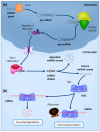MicroRNAs as Biomarkers and Therapeutic Targets in Female Infertility
- PMID: 39684688
- PMCID: PMC11640832
- DOI: 10.3390/ijms252312979
MicroRNAs as Biomarkers and Therapeutic Targets in Female Infertility
Abstract
The study of microRNAs (miRNAs) has emerged in recent decades as a key approach to understanding the pathophysiology of many diseases, exploring their potential role as biomarkers, and testing their use as future treatments. Not only have neurological, cardiovascular diseases, or cancer benefited from this research but also infertility. Female infertility, as a disease, involves alterations at multiple levels, such as ovarian and uterine alterations. This review compiles the latest studies published in humans that link female disorders that affect fertility with altered miRNA profiles. Studies on ovarian alterations, including diminished ovarian reserve (DOR), poor ovarian response to stimulation (POR), premature ovarian insufficiency (POI), and polycystic ovary syndrome (PCOS), are summarized and classified based on the expression and type of sample analyzed. Regarding uterine disorders, this review highlights upregulated and downregulated miRNAs primarily identified as biomarkers for endometriosis, adenomyosis, decreased endometrial receptivity, and implantation failure. However, despite the large number of studies in this field, the same limitations that reduce reproducibility are often observed. Therefore, at the end of this review, the main limitations of this type of study are described, as well as specific precautions or safety measures that should be considered when handling miRNAs.
Keywords: infertility; microRNA; ovarian alterations; uterine disorders.
Conflict of interest statement
The authors declare no conflicts of interest.
Figures

Similar articles
-
Upregulated let-7 expression in the follicular fluid of patients with endometriomas leads to dysfunction of granulosa cells through targeting of IGF1R.Hum Reprod. 2025 Jan 1;40(1):119-137. doi: 10.1093/humrep/deae247. Hum Reprod. 2025. PMID: 39521729 Free PMC article.
-
microRNAs in female infertility: An overview.Cell Biochem Funct. 2021 Dec;39(8):955-969. doi: 10.1002/cbf.3671. Epub 2021 Oct 27. Cell Biochem Funct. 2021. PMID: 34708430 Review.
-
Endometrial miR-543 Is Downregulated During the Implantation Window in Women With Endometriosis-Related Infertility.Reprod Sci. 2019 Jul;26(7):900-908. doi: 10.1177/1933719118799199. Epub 2018 Sep 19. Reprod Sci. 2019. PMID: 30231774
-
miR-196a overexpression activates the MEK/ERK signal and represses the progesterone receptor and decidualization in eutopic endometrium from women with endometriosis.Hum Reprod. 2016 Nov;31(11):2598-2608. doi: 10.1093/humrep/dew223. Epub 2016 Sep 12. Hum Reprod. 2016. PMID: 27619769
-
Metabolic signature of follicular fluid in infertility-related diseases: a narrative review.Reprod Biomed Online. 2024 Jun;48(6):103762. doi: 10.1016/j.rbmo.2023.103762. Epub 2023 Dec 5. Reprod Biomed Online. 2024. PMID: 38537523 Review.
Cited by
-
The Role of miRNA in Endometriosis-Related Infertility-An Update.Int J Mol Sci. 2025 Jun 19;26(12):5862. doi: 10.3390/ijms26125862. Int J Mol Sci. 2025. PMID: 40565325 Free PMC article. Review.
-
Epigenetic Alterations in Ovarian Function and Their Impact on Assisted Reproductive Technologies: A Systematic Review.Biomedicines. 2025 Mar 17;13(3):730. doi: 10.3390/biomedicines13030730. Biomedicines. 2025. PMID: 40149706 Free PMC article. Review.
-
Clinical pregnancy outcomes in young women with diminished ovarian reserve undergoing frozen embryo transfer: a comprehensive analysis with exploratory insights into endometrial aging.Front Endocrinol (Lausanne). 2025 Jul 29;16:1608200. doi: 10.3389/fendo.2025.1608200. eCollection 2025. Front Endocrinol (Lausanne). 2025. PMID: 40801036 Free PMC article.
-
Exosomal Communication Between Cumulus-Oocyte Complexes and Granulosa Cells: A New Molecular Axis for Oocyte Competence in Human-Assisted Reproduction.Int J Mol Sci. 2025 Jun 3;26(11):5363. doi: 10.3390/ijms26115363. Int J Mol Sci. 2025. PMID: 40508172 Free PMC article. Review.
-
Recent Advances and Clinical Outcomes of Endometriosis.J Clin Med. 2025 Jan 26;14(3):798. doi: 10.3390/jcm14030798. J Clin Med. 2025. PMID: 39941469 Free PMC article.
References
-
- Damsgaard J., Joensen U.N., Carlsen E., Erenpreiss J., Jensen M.B., Matulevicius V., Zilaitiene B., Olesen I.A., Perheentupa A., Punab M., et al. Varicocele is associated with impaired semen quality and reproductive hormone levels: A study of 7035 healthy young men from six European countries. Eur. Urol. 2016;70:1019–1029. doi: 10.1016/j.eururo.2016.06.044. - DOI - PubMed
-
- Concepción-Zavaleta M.J., Coronado-Arroyo J.C., Quiroz-Aldave J.E., Durand-Vásquez M.d.C., Ildefonso-Najarro S.P., Rafael-Robles L.d.P., Concepción-Urteaga L.A., Gamarra-Osorio E.R., Suárez-Rojas J., Paz-Ibarra J. Endocrine factors associated with infertility in women: An updated review. Expert Rev. Endocrinol. Metab. 2023;18:399–417. doi: 10.1080/17446651.2023.2256405. - DOI - PubMed
Publication types
MeSH terms
Substances
LinkOut - more resources
Full Text Sources
Medical

